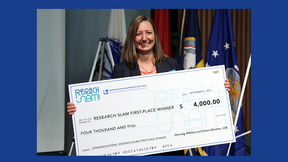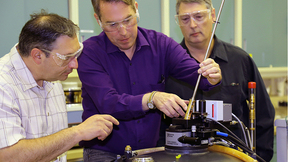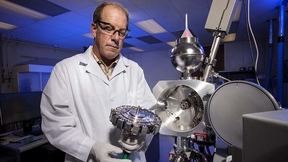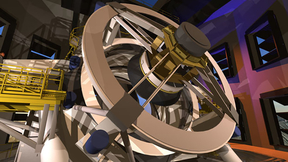Back
Physical and Life Sciences
Lawrence Livermore and American Heart Association partner to accelerate drug discovery
The American Heart Association (AHA) and Lawrence Livermore National Laboratory (LLNL) have formed a strategic business partnership to overcome the burden of drug discovery, cost and access. The two organizations will leverage the world’s most powerful supercomputers to accelerate drug discovery. LLNL scientists and engineers in collaboration with AHA-funded scientists…
Lab employees selected as 2017 APS fellows
Three Lawrence Livermore National Laboratory (LLNL) scientists -- Nathan Barton, Lab Director William Goldstein and Robert Kirkwood -- have been selected as 2017 fellows of the American Physical Society (APS). Election to APS fellowship recognizes the society member's exceptional contributions to the field of physics through research, leadership, applications of physics or…
Public-private consortium aims to cut preclinical cancer drug discovery from six years to just one
Lawrence Livermore National Lab, Frederick National Laboratory for Cancer Research, GSK and University of California, San Francisco will combine vast data stores, supercomputing and scientific expertise to reinvent discovery process for cancer medicines. SAN FRANCISCO, Oct 27, 2017 -- Scientists from two U.S. national laboratories, industry and academia today launched an…
LLNL researchers turn to bioengineered bacteria to increase U.S. supply of rare earth metals
To help increase the U.S. supply of rare earth metals, a Lawrence Livermore National Laboratory (LLNL) team has created a new way to recover rare earths using bioengineered bacteria. Rare earth elements (REEs) are essential for American competitiveness in the clean energy industry because they are used in many devices important to a high-tech economy and national security,…
Exascale in motion on earthquake risks
Assessing large magnitude (greater than 6 on the Richter scale) earthquake hazards on a regional (up to 100 kilometers) scale takes big machines. To resolve the frequencies important to engineering analysis of the built environment (up to 10 Hz or higher), numerical simulations of earthquake motions must be done on today’s most powerful computers. The algorithms and codes…
Big, bad, Martian volcanoes unveiled
They are bigger, scarier and last longer. That’s the conclusion of a team of scientists, including Lawrence Livermore National Laboratory cosmochemist Bill Cassata, about the evolution of volcanoes on the red planet, compared to those on Earth. Martian volcanoes are the largest in the solar system. Although their size indicates continued activity over billions of years,…
LLNL scientists stick to a new efficient magnet
Lawrence Livermore National Laboratory researchers have developed a new, more efficient permanent magnet that removes the deficiencies of conventional samarium and neodymium magnets. The proposed magnet stems from the well-known samarium and cobalt (SmCo5, CaCu5-type structure) magnet, but goes a step further and substitutes most of the cobalt with iron and nickel. More…
New ultralight silver nanowire aerogel is boon for energy and electronics industries
A new ultralight silver nanowire aerogel could be a boost to the energy and electronics industries. Metal foams (or porous metals) represent a new class of materials with unique properties including lightweight, high surface area, high electrical conductivity and low thermal conductivity. Lawrence Livermore National Laboratory (LLNL) researchers have created a new…
Scientists estimate death rates from air pollution caused by the impact of climate change
A recent study by Lawrence Livermore National Laboratory (LLNL) scientists and collaborators is the first to use an ensemble of global chemistry climate models to estimate death rates from air pollution caused by the impact of climate change on pollutant concentrations. Ground-level ozone and fine particulate matter are detrimental to human health. Their future…
Atomic-scale simulations go the distance to resolve the 'jiggle, wiggle' of metal strength
Lawrence Livermore National Laboratory (LLNL) researchers have dived down to the atomic scale to resolve every "jiggle and wiggle" of atomic motion that underlies metal strength. In a first-of-its-kind series of computer simulations focused on metal tantalum, the team predicted that, on reaching certain critical conditions of straining, metal plasticity (the ability to…
LLNL researchers to study soil microbiome
A new Lawrence Livermore National Laboratory (LLNL) initiative to study how the soil microbiome (microorganisms such as fungi and bacteria, microfauna and viruses) controls the mechanisms that regulate organic matter stabilization in soil can move forward after the Department of Energy’s (DOE) Office of Biological and Environmental Research awarded an LLNL team $2.5…
A solid pathway toward hydrogen storage
An inexpensive and useful layered superconductor compound also may be an efficient solid-state material for storing hydrogen. The Department of Energy's (DOE) Energy Materials Network (EMN) consortium approach to accelerate material discovery and development is starting to pay off. Through theory and experimentation, Lawrence Livermore National Laboratory (LLNL) scientists…
Twenty summers of nuclear forensics and actinide science
In 1998, the Actinide Sciences Summer Program began training the next generation of actinide scientists (those who study elements 89 through 103 in an effort to identify the origin and behavior of nuclear materials). On August 5, this longstanding program, renamed the Nuclear Forensics Summer Internship Program (NFSIP) in 2008, bid farewell to its 20th class. As a…
2017 Research Slam is a hit
On Sept. 7, 2017, 12 postdoc finalists of Lawrence Livermore National Laboratory's 2017 Research Slam! talked for three minutes each about their work before a distinguished panel of judges. The postdocs were competing for monetary prizes of two, three and four thousand dollars for third, second and first place winners, but perhaps the biggest prize was the chance to…
Lab wins six DOE commercialization grants
For two years running, Lab researchers have exceeded expectations for capturing Department of Energy (DOE) Technology Commercialization Fund (TCF) grants. In 2016, the first year of the TCF competition, Rich Rankin, the head of the Lab’s Innovation and Partnerships Office (IPO), expected LLNL might win one proposal. The Lab won two. This year, Rankin and others hoped Lab…
Lab researchers achieve '4D printed' material
For the first time, Lawrence Livermore National Laboratory (LLNL) researchers have successfully 3D printed composite silicone materials that are flexible, stretchable and possess shape memory behavior, a discovery that could be used to create form-fitting cushioning activated by body heat, such as in a helmet or shoe. As described in their paper published online by…
Using synthetic biology for chlamydia vaccines
A multidisciplinary scientific team at Lawrence Livermore National Laboratory (LLNL) has made significant advances in developing a vaccine for chlamydia using synthetic biology, sponsored by a two-year National Institutes of Health (NIH) grant. They detail their work in a recent paper published in the Journal of Biochemistry (JBC): "Cell-Free Production of a Functional…
Lab physicist elected SPIE senior member
Lawrence Livermore National Laboratory (LLNL) physicist Regina Soufli has been elected as an SPIE senior member. SPIE, the international society for optics and photonics, bestows the senior member designation on individuals who have distinguished themselves through their professional experience and their active involvement within both the optics community and SPIE. Soufli…
Unlocking the History of the Solar System
Detailed chronologic investigations performed by Livermore researchers using newly developed techniques to precisely date individual samples with confidence indicated that all the samples solidified within a narrow window of time.
The Widest, Deepest Images of a Dynamic Universe
Unaided and under the darkest conditions, the human eye can see only about 9,000 stars around Earth. The Large Synoptic Survey Telescope (LSST)—looking at only half of the night sky—is expected to detect an estimated 17 billion stars and discover so much more over the course of a 10-year mission.

























